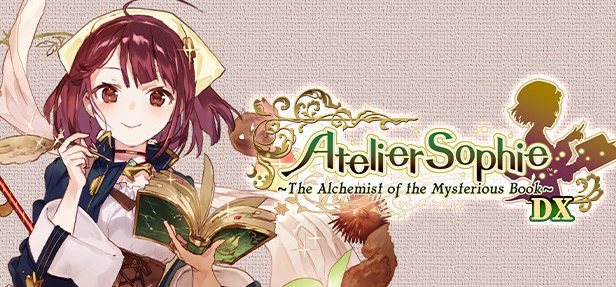Everything old is new again! The Mysterious Trilogy that started my enjoyment of the Atelier series is back in a new DX package.
Type: Single-player
Genre: RPG
Developer: KOEI TECMO
Publisher: KOEI TECMO
Release Date: 21 Apr, 2021


Reviewer’s Note
Some of you may remember the old days when I was an independent reviewer writing the Indie Spotlight on RWS before Save or Quit recruited me… actually… probably none of you do… but that is okay. Back then I used to do a different style of review and often did it in a deliberately over the top way that could span up to 10 pages of text. I toned that down for Save or Quit and take things more seriously now. However, I have decided since the Mysterious Trilogy is being rereleased in a Deluxe way, that perhaps I should go back to my old ways just this one time and do an Indie Spotlight style including the idiosyncratic opening!
Indie Spotlight
Recently I was introduced to the concept of putting various ingredients into a pot then stirring it together to produce something completely new and hopefully exciting. Sadly though, whenever I do it, it is inevitable I always just end up with some really weird tasting soup. Clearly, I am not cut out to be a world-class chef. Luckily, there are rumours circulating that there is a magical cauldron out there that can let anyone, even someone without any skills at all, make wonderful things just by mixing a few indiscriminate items together. That sounds like it would be perfect for me. Mind you, I heard about it from a strange book that randomly started talking and flying around on its own so it is also quite possible I am starting to go a bit insane. I can’t tell if that is a guiding light on the horizon glinting off a soaring projectile or if it is the glow of the Indie Spotlight reactivated once again, this time featuring Atelier Sophie: The Alchemist of the Mysterious Book DX.
You Can Do Anything with Alchemy… Probably!
Atelier Sophie: The Alchemist of the Mysterious Book DX is the first game of the Mysterious trilogy arc of the long running Atelier series. Atelier Sophie starts out with Sophie trying to mimic her late Grandmother’s Alchemy skills so she could use them to help her village by fulfilling their requests. She tries her best but she is still quite the novice. One day while struggling to remember one of her Grandmother’s recipes, she conveniently found an old recipe book that had belonged to her Grandmother. Flipping through it she remembered how to make what she wanted, and promptly wrote it down in the book. Suddenly, the titular Mysterious Book came to life, started talking, flying around and offering guidance to Sophie to help her gain skills so that she can write even more recipes into it. Encouraged by her new found guide, and supported by her childhood friends, Sophie sets off to find materials in order to hone her Alchemic skills and become the next great Alchemist of Kirchen Bell.
Kirchen Bell is the only town in Atelier Sophie: The Alchemist of the Mysterious Book and acts as a central hub for the game world. Once you have access to the world map, you are free to do almost anything you want. There will be very few places you can actually visit at first but as the game progresses, more areas for you to visit will be revealed. Let’s start with Kirchen Bell itself. While inside the town you are able to visit various places and interact with the NPCs that live out their digital lives there. There are a few that are noteworthy, especially in the early phase of the game. The various shopkeepers all tend to enjoy talking to you and will sometimes request your aid. Some of them will even end up joining your party later on so it is probably a good idea to talk to them and fulfill their requests as they come up. Basically, anyone who has a portrait of their face on the city map is likely someone you will want to get to know. There is one person known as “King of the Fetch Quest” who is quite important to you and that is the Bartender. He will frequently have requests available for you to look after and will also sell you a few rumors. It is a really good idea to check with him regularly as he will often help you find materials you might not be otherwise able to get on your own. He will also give you extra Cole (money) to spend on the things you may need in exchange for your doing something you likely would have done anyway. The Atelier is one of the main sites you will visit in the game. It is Sophie’s home as well as where your Alchemic Cauldron is accessed. I will talk about Alchemy in more detail later on, but I will say this right now, you will be spending most of the game seeking out the items needed to discover or make things with that cauldron.

When you leave Kirchen Bell, you are placed onto a train-track style world map. You must pass through all stops between where you want to go and where you are. Each time you hit a stop your LP (energy) will decrease a bit and thus force you to return to the Atelier from time to time to unload what you found and recharge your energy. While you will not be automatically teleported back to the Atelier when you run out of LP, you will find yourself unable to fight effectively. This might sound like a “Well if you are out of LP just run back to Kirchen Bell then” type situation, however, there are often “Red Dots” on the world map that act as random encounters. Sometimes these encounters are positive, granting you Cole, HP, MP or LP but sometimes they also offer you up a fight which can at times be a really hard one especially if you are low on LP. Suddenly a weak Puni is a serious threat to you! I have to say I have mixed feelings here. Atelier Sophie and Atelier Firis handled the world map differently. Atelier Sophie let you return to Kirchen Bell (or any other stop) quickly and easily just by pointing to it on the map and telling her to go there. Atelier Firis, on the other hand, did away with that style map as best I could tell and forced you to walk back through zones in order to revisit an earlier area. I honestly can’t say which I liked better. Firis’ everything is connected world, the portable Atelier, and the realism that yes to get from point D back to point A you would need to visit C and B on the way, or Sophie’s just skip what you don’t want to visit and leg it back and forth at will. I also disliked having to spend a long time hoofing it back to an earlier area to grab materials from there in Atelier Firis and enjoy the fact that in Atelier Sophie I can easily revisit any area I want if I need to stock up on a few things. In the end, I can’t really say which the better implementation is. I feel like it made Atelier Firis feel like a much grander scale game than Atelier Sophie, however, if you ignore that factor, the basic core gameplay is the same.
The reason why I mentioned Atelier Firis versus Atelier Sophie’s handling of the world map is because it impacts what I am about to discuss next. In Atelier Firis, you wander around the world map as you journey down one of the various roads to the next zone destination in a wide-open world. There are plenty of nooks and crannies to find and various branching routes that lead you through even more areas as you work your way towards your ultimate destination. Within each of the zones there are various special areas for you to visit such as caves which are smaller contained areas for you to explore in order to find a chest or rare materials for you to craft with. In Atelier Sophie you skip the time consuming wandering between places and just appear in the exact place you want to be. This means that you will spend most of the game popping out of your Atelier, going to one or two places, harvesting/killing in a small area, then going home to craft with the spoils you bring home rather than getting the feeling you are exploring the world. Atelier Sophie is all about crafting whereas Atelier Firis is more about the journey. There is nothing wrong with that and I am still on the fence of which system works better in the end.
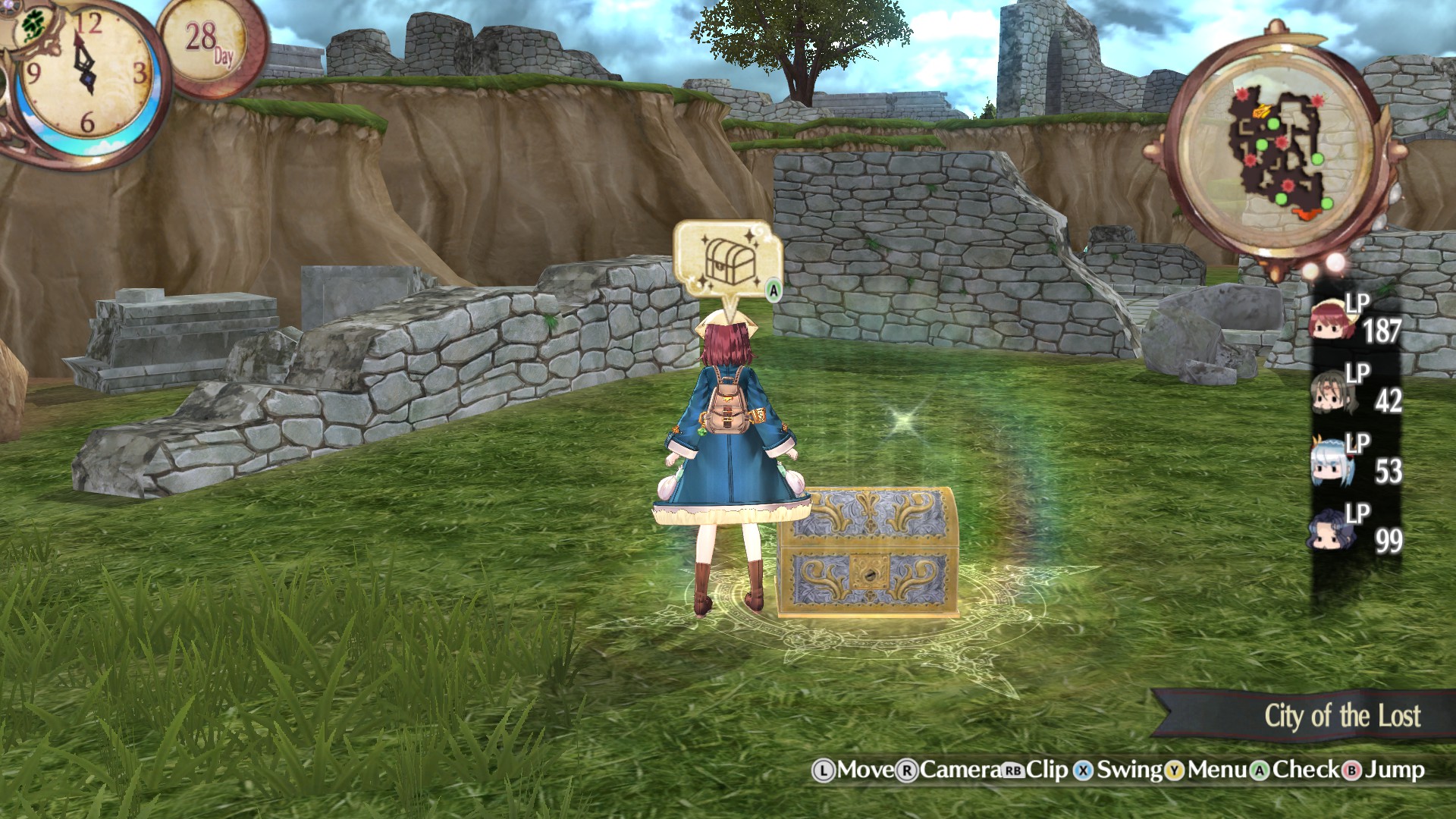
The reason why you leave your Atelier in either game is so you can collect materials in order to pursue your Alchemy skills. Your motivation for doing so changes depending on the game, but from here on out we are focusing solely on Sophie’s Quest. Plachta, the flying book that can talk as mentioned earlier is suffering from amnesia. She cannot remember anything about her past but having Sophie write into her helps her remember things. Since Sophie wants to become a better Alchemist, like her Grandmother had been, their goals mesh together well. Plachta decides to share anything she remembers with Sophie so long as she keeps helping her remember things. Sophie goes about writing things into Plachta as she discovers new recipe ideas. You discover these ideas either by following the recipe hints in your recipe book or just by chance when you discover something new in the field on your own. As your abilities improve, a progress bar fills up that eventually triggers another memory from Plachta. The nice thing about these memories, besides the fact they flesh out the game’s plot, is the fact that she will often remember new gathering areas where Sophie can go find new materials. Between talking to NPCs and filling out the pages of Plachta, Sophie will soon discover all the available places she can visit to gain new materials to improve her skills. It is kind of a circle like that for the bulk of the game. Find and make better stuff so that you can discover how to find and make even better stuff. As mentioned, Atelier Sophie is all about the crafting with Alchemy rather than world exploration.
Alchemy is much like making a pot of item soup, so my traditional odd-ball introductory paragraph is actually much more apt this time than usual. If you add the correct ingredients you will end up with something passable. If you use good quality ingredients odds are you will end up with something even better. The spices you add also help to really enhance the flavor of the soup you make even if they do not exactly add much sustenance to the soup in general. As you visit the various zones, kill the monsters you find there and gather all the sparkling materials laying around, you will find yourself with quite the assortment of elements to add to your item soup. The game will help you out a bit by telling you the basic recipe to make whatever item it is you are trying to make, that is assuming you have discovered the recipe in the first place. Once you select the item, it will take you to a screen that is broken down into suitable component ingredients. Much like when making a real soup, sometimes a few minor substitutions can be made and you will still end up with basically the same thing. While looking at the suitable ingredients needed to fulfill the particular component, you will generally see various similar class items that will work. Making the correct choices will help you generate a much better item than if you just chose from them randomly. Each item has a quality level, size component and sometimes transferable traits. Items with larger numbers or higher letters will have more impact on the item quality and available effects than those with lower numbers or letters. For example, if you are trying to unlock higher effects from an item, you will need to use item components that have high enough effect impacting numbers in order to score enough points to unlock it, otherwise you will get a more generic version of your end product. Some traits will also combine to form a higher-level version of the trait so that is something you should watch out for as well. It is really not that difficult to perform Alchemy and depending on the stats of the cauldron you are using it can be quite easy to unlock the higher tier effects and traits if you plan ahead.

The Alchemy cauldron in Atelier Sophie can be upgraded or substituted at any time you wish. If you have the materials required, you can try to upgrade the cauldron to have new abilities or higher capacity. I have to say being able to rotate components will make your life much easier when trying to maximize your item scores to unlock higher level effects. Each of the cauldrons has their own special features so you need to choose wisely which one you will use for which craft. Your Grandmother’s cauldron works well as a training cauldron that you can’t possibly fail with but you will find it harder to really maximize the potential effects from items later on with it even if you upgrade it fully. The Expert cauldron on the other hand makes it much easier to score higher values, but you are fighting against time to lay it out properly. There are a few other cauldrons available too, but I will leave those to your discovery, just know that each one, for the most part, serves a different role in your Alchemic pursuits. Alchemy goes one step further than just dumping everything into the cauldron though, you have to be careful about where you place the items in it. Matching colours, placing it on bonus tiles, avoiding overlaps all will help you raise your total trait potential from your newly made item.
Alchemy is not the only form of crafting you will do in this game, so do not spend all your materials in one place! The local Blacksmith and the Clothier are both able to craft new gear for you. It works like an easy-mode version of the Alchemical crafting. You pick what it is you want to make, select what materials you want to use to make it, and pay the person to make it for you. You can allocate the same transferable trait bonuses to the item the same way you can to the things you make in alchemy in order to further customize the piece of gear. Even after the item is made you can further enhance it by paying the crafter to combine the piece of gear with another random suitable item. You can only do this a limited number of times per item however, so you are best to use the highest quality you can at every step of the way to ensure you have the best possible version of that particular piece of gear.
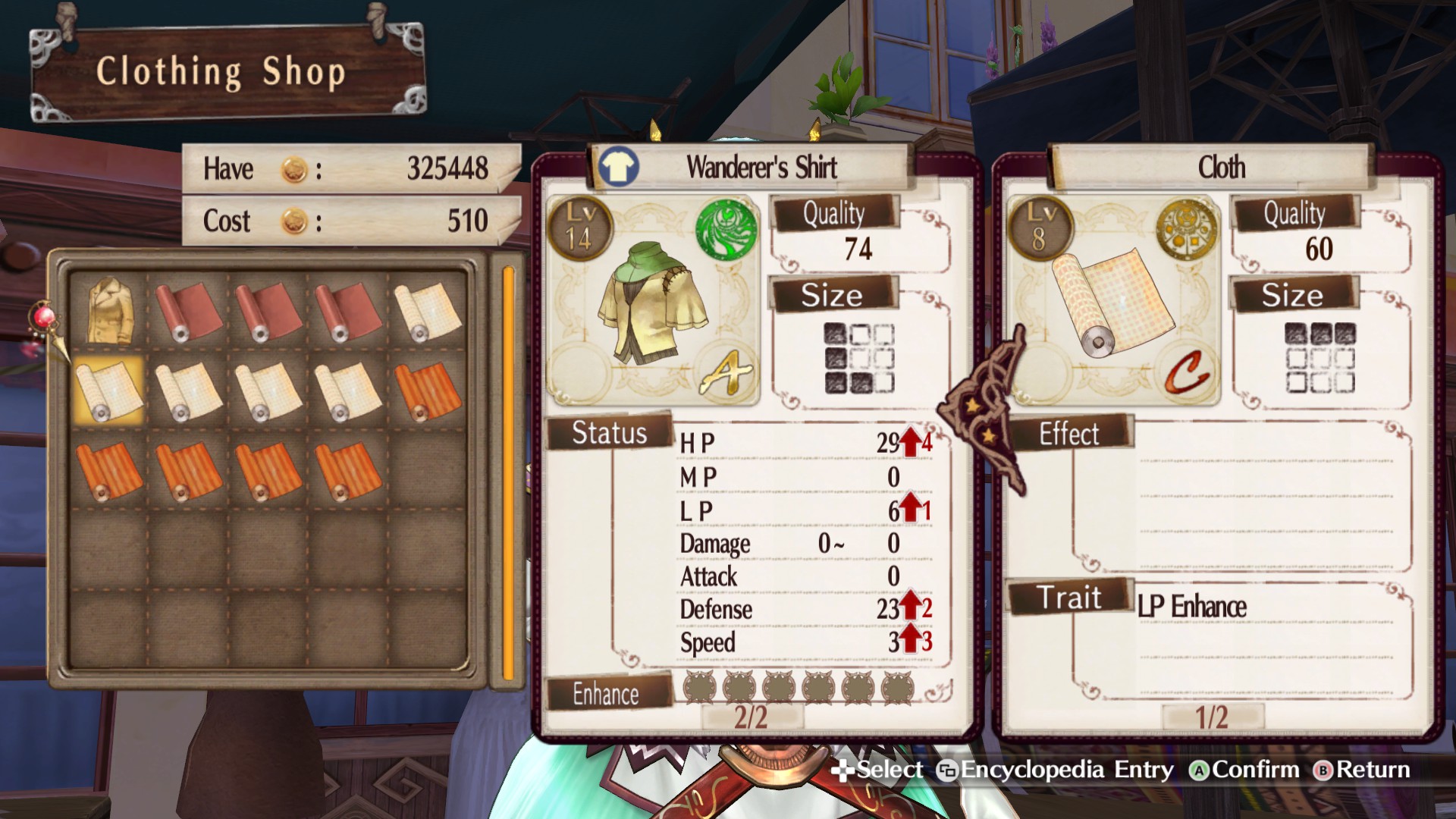
There is still another way to spend your hard-earned quality materials that becomes available later in the game: Doll Making. Doll Making lets you customize the body of one of the characters that becomes available later in the game. Depending on which materials you choose impacts four major categories for the character. Once you have placed all items, you are given a list of designs to choose from. If you have already unlocked the design, it will show up by name, if you have not, it will show up as “??????” until you select it the first time. It adds for an interesting element later in game that can be quite fun to play around in.
The way time works in this game is a bit interesting as well. There is a day/night cycle that dictates when stores will be opened or closed and which enemies/materials will spawn, but there is also a day of the week and month system in play as well. Day of the week impacts several different things and while admittedly it is not always obvious what it does, I can definitely say it does something! It can change which materials you can gather out in the field, impacts what rumours/requests are available and also some important events for the NPCs can only happen on certain days of the cycle. Other than for hunting requests, there really is no time limit in this game so you can take your time to do anything you want whenever you feel like doing it. I know when I played Atelier Firis I felt pressured to keep moving and not waste too much time as there was a countdown clock threatening to end my journey prematurely, and I can say that I felt no such pressure in Atelier Sophie.
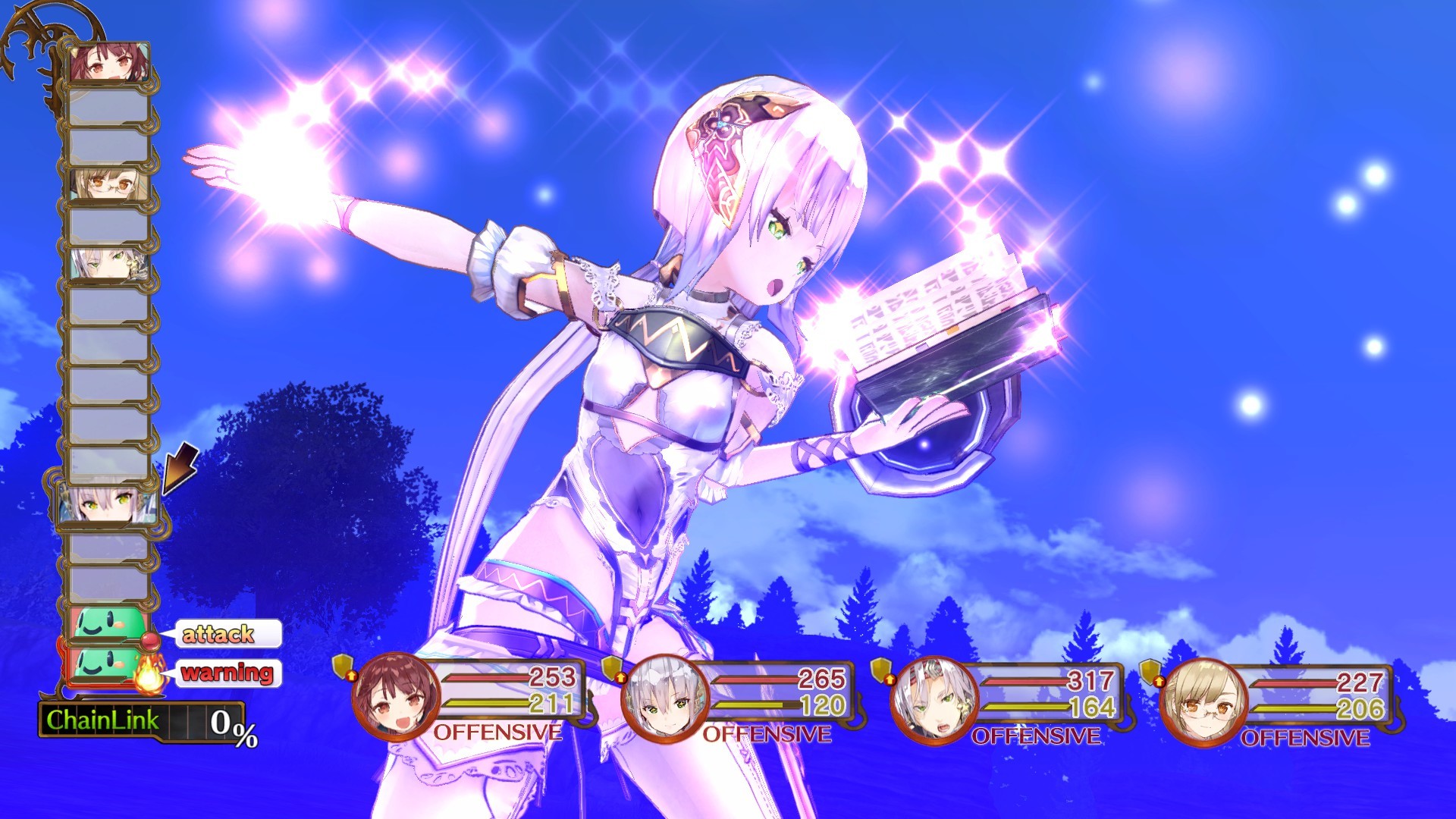
Combat
It would be too easy and a bit dull if all you had to do in this game was to wander around aimlessly gathering things to pursue your Alchemy skill. When you venture out of the safety of Kirchen Bell, as alluded to earlier, you will very likely find yourself ending up in combat. The difficulty setting you choose really comes into play here. I cannot stress that enough. I admit, from time to time, especially if it is a game from a series I have played before, I often go for the higher difficulty settings just for the sake of any achievements or bonuses that may be gained by doing so. This review was actually delayed a bit because I was being stubborn. I opted for Despair difficulty, which is harder than hard. I went into my first battle, against some Puni (A slime-like monster that one might confuse for a tasty gelatin treat) and found it to be a decent challenge, but nothing to get excited over. I patted myself on the back for making the right choice and pressed on. Plachta remembered some new gathering fields for me to go collect stuff in so I went there promptly. Gathered a bunch of items and got jumped by a monster that sort of looks like a wolf. No big deal, let’s do….this…. OMG you killed Kenny! I mean Sophie! Luckily Oskar and Monika will be there to… hmm, well gosh dang-it that was unfortunate, I lost most of the stuff I gathered and woke up back in my Atelier. Looks like I will have to play it a bit smarter! I used what I could to craft myself better weapons and armor, made the best accessories I could make and went off to seek revenge against the great white wolf that wiped me out… after about 27 attempts and failures later I was starting to see why this was called Despair difficulty. I spent some time grinding up levels in areas that I knew I could survive until I was strong enough to beat that wolf… who am I kidding, it still killed me. I ended up just avoiding it and most other monsters as I frantically gathered better materials so I could better equip myself. Even now that I am at the highest possible level, and wearing almost the best gear in the game, I am still finding myself getting wiped out far more than I care to admit. I would strongly suggest playing the game on Normal for your first time, heck I wouldn’t think less of you even if you played it on easy. Even Hard difficulty lives up to its name at times.

Combat in this game is turn based, and the turn order is based on the character’s speed and any other speed modifying spells and abilities used compared to that of the enemies and other in play characters. Assuming no turn-delaying spells are cast by the enemy, the turns will flow as they are depicted on the side of the screen. This should give you a general idea of when your character will carry out the action you specified for it to do. For example, it would make little sense to tell one character to heal a fallen comrade and another to revive said comrade after the fact. As you can see, paying attention to the turn order will likely prove to be quite important while strategizing your next move. When first starting out, Sophie is pretty much useless in combat when she is just wielding her staff as a weapon. This is where her Alchemy comes into play however. Sophie can make explosives to hurl at her enemies. Depending on how well she made them, which traits and effects they have and a few other factors, Sophie can actually do pretty decent damage. In the early game this enables her to hold her own in a fight just like her stronger shovel and sword wielding allies. At the start of a combat phase, you are given the ability to select what you want each character to do. You can have them use one of their abilities, use an item they have equipped, attack with their weapon or run away. I have to say that the run command never actually seems to work for me. I think in all the time I have used it, it worked once and the enemy pretty much jumped me again instantly before I even had a chance to run away from the room it was in. That could be thanks to Sophie getting the bright idea to write down a new item idea she had while escaping combat which let the monster jump her again while she was distracted with her notebook, I’m not sure. It wiped me out the second time! You can also choose if you want them to be Defensive or Offensive in combat. As they perform most actions, a gauge will fill at the bottom of the screen. Once it hits the current maximum level for it, it will unleash a powerful move that will drain the bar back down again. It is that power move that has saved my life a few times thanks to it triggering right when I needed it most! Another nice feature is the fact your characters can chain their attacks together. Even if the character already had its turn, it might decide to support another of their allies in combat by running up and beating on the monster with their weapon again after the other character made their move. Sometimes multiple characters will act in the chain meaning that same character might actually get two or three turns per round. Overall though, the combat system works quite well. If you want to avoid a fight you can generally carefully avoid it by simply not getting too close to the enemy or by out running or hiding from it. If you do trigger the combat, you will see whatever monster it was that was roaming the battlefield as well as any friends the monster might have assisting it. Winning in combat will often grant you items you can use to make new things and also sometimes will grant you a bonus treasure chest. The chest will sometimes contain new gear and/or additional materials for you to craft which are different from what you would normally get for fighting that particular monster type.
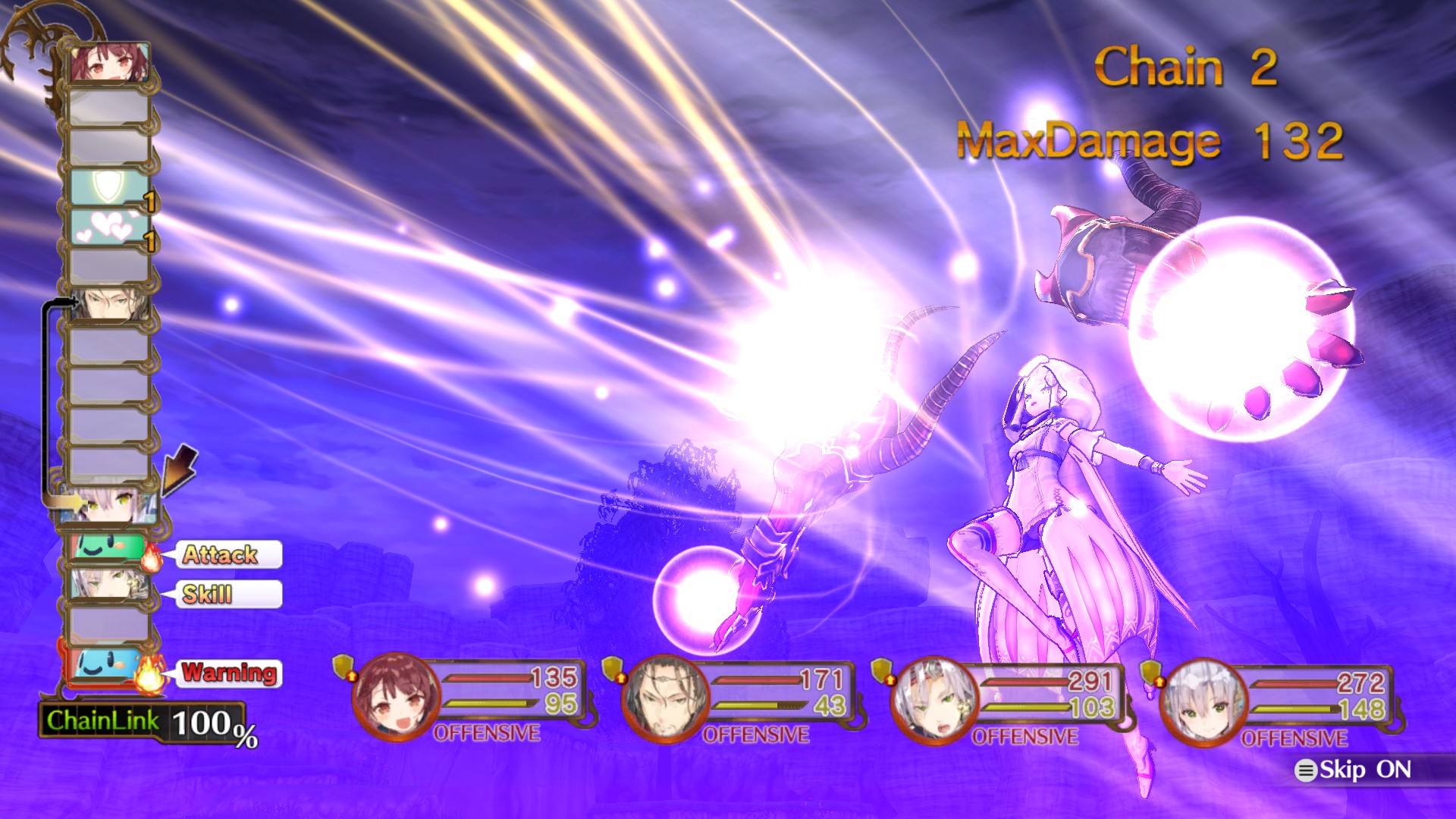
The level up system in this game is interesting. For the first twenty levels, the game automatically grants and allocates you the various abilities and skill points earned for each level. You do not really have to do much other than feel good that your characters just became a little stronger. After you hit level 20 you will find that the game sets the allocation to manual control at that point. Now when you get enough experience to level up, you are simply granted an allocatable point. Once you gather up enough of these points you can pick and choose what you want to spend them on. The final boss on Despair and most of the enemies hanging around in their base of operations were almost too much for my party to handle, however, the tables eventually turned as I had been raiding the place for extremely high quality and level materials to fashion myself powerful gear with strong traits. Once your finally take down the final boss the post-game content becomes available.
The characters of Atelier Sophie are all fun and interesting to deal with; Sophie herself is a hard-working person who tries her best to make everyone happy even if she doesn’t plan things out fully in advance. Oskar, a merchant’s son who is quite lazy and also can talk to plants and beat monsters up with a shovel. Harol is a lazy clock-repairing gun aficionado narcissist that secretly has a heart of gold buried under his cold exterior (don’t tell him I said that). Fritz is a mysterious swordsman who loves making dolls and performing puppet shows. Plachta is a talking book that can fly. You cannot say you have encountered too many of those in games! I could go on and detail all of the characters, but it would be far more fun for you to get to know them yourself. I will just say they make for quite the ragtag team, but they do work quite well together.
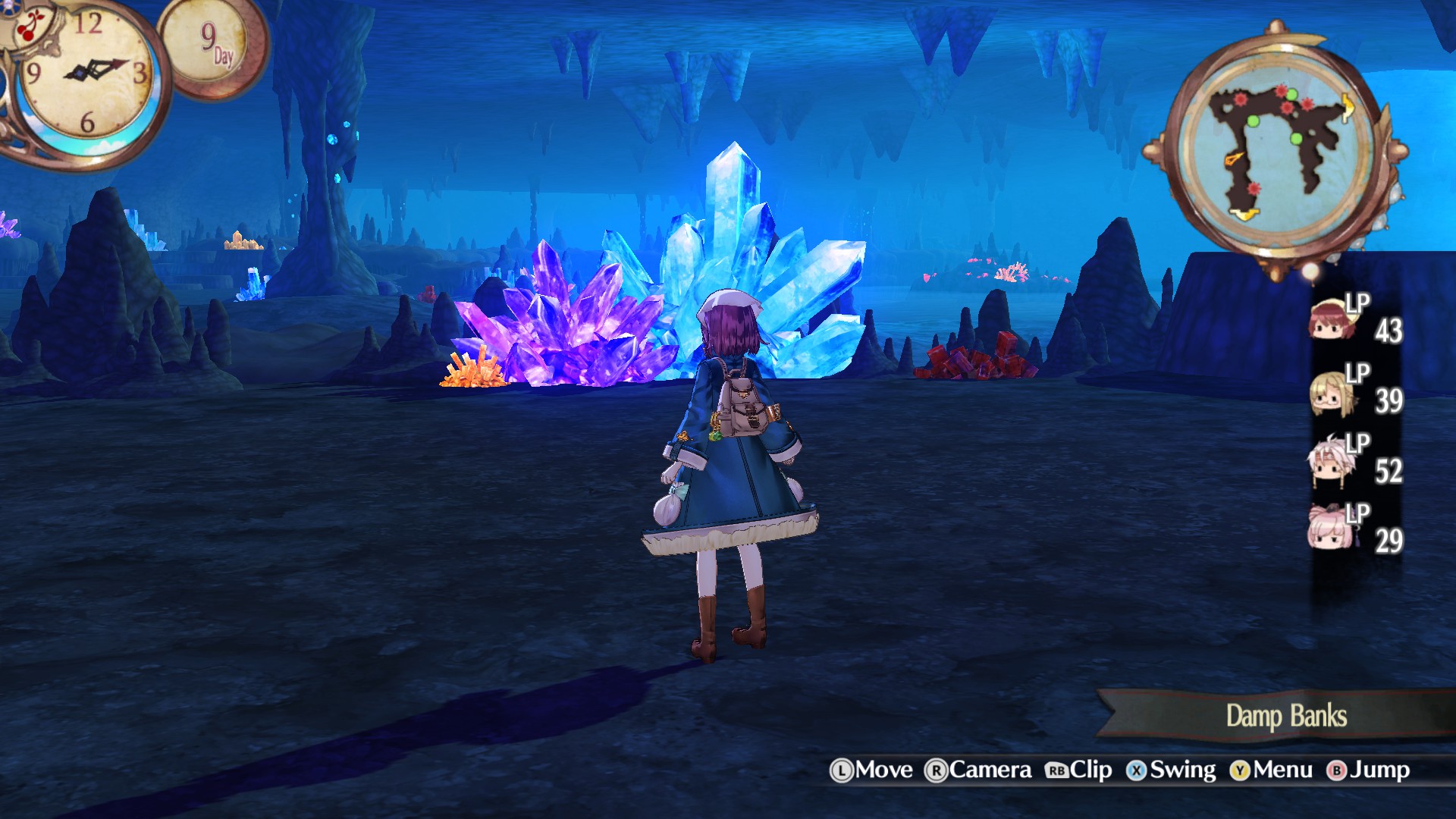
Graphics
Visually, the game looks quite beautiful with its anime-style design. You can really see that a lot of detail went into designing each of the characters. Each of the character models, be them NPCs or part of your team, have a lot of detail in both their features and their clothing. Both Sophie and a certain other character can change their clothing based on the players taste. I’d mention who that is but it would spoil a big event in the game (which the game actually spoils in the opening act of the game, but still keeps it as a big reveal later anyway!) Sophie has a limited number of outfits to choose from while [redacted] has considerably more to choose from depending on what you unlock during Doll Making. One really nifty feature that is a case of the Developer going above and beyond is the fact that if you change Sophie’s outfit in game, her outfit on the title screen will change to match it as well. The world map is fairly plain; however, each of the locations has a logo that helps you identify what kind of elements the zone will be featuring. Once you actually arrive at the zone, there is an area presented to you. Usually it is a single stage that lets you wander around the small area collecting and fighting things until you find yourself wandering back to an exit. Sometimes you will be able to venture even deeper into the stage to discover even more enemies, materials, and treasures to collect. Sometimes you may even encounter extra strong boss-like monsters to fight in order to gain access to an extra special treasure. There is enough detail to make each zone look good and interesting, but there isn’t always that much variance between some zones. It is mostly just a different layout. The same can be said for the monsters in this game. There really is not that much variety. Usually, you are fighting the same monsters in each zone but with some recolouring and different abilities/stats to add variety. Honestly, that is really the only complaint I can come up with for this game. It would have been nice had there been a few more monster designs in it just for the sake of visual appeal and interest.
Audio
The audio in Atelier Sophie works quite well. Dialogue is delivered either via just text boxes on the screen or often times, spoken by the characters in question…and in English too! You can generally tell in this game who will be important and who will not be simply by the fact they have some voiced dialogue. The accompanying music really suits the game and makes it feel more atmospheric. As the time of day changes often too will the music to help give the sense that time really is changing. I have to say even when the music repeats itself, that I still found it quite enjoyable and never felt the compulsion to turn off the music track. It is just such soft and sweet music that is almost impossible to become irritated with even after you have listened to it for hours on end.
Controls and User Interface
The controls of this game work quite well. I mostly used a gamepad to play it and I never once found myself having any difficulty figuring out how to do something nor had any issues making the game do what I intended. The menus are all easy to navigate, and the on-screen prompts generally coincided nicely with what button presses I needed to do in order to access what I needed. The keyboard works for the game as well but my experience with that was more limited. I was able to easily figure out the correct keystrokes to perform most actions.
DX Differences
So, what exactly makes this the DX version of Atelier Sophie? Besides the visual upgrade, which is not exactly that noticeable since the original edition looked so very good, it includes a lot of the DLC that was separate before. It also includes new episodes of Sophie’s growth as an alchemist as well as new cauldrons to experiment with. The ability to sprint in order to cover distances faster (like you can in some other Atelier titles) and a fast forward ability if battles are getting a bit tiresome for you. There is also a photo mode which I actually accidentally triggered a number of occasions that is great for taking screenshots though, especially if you want one of you being chased by enemies.
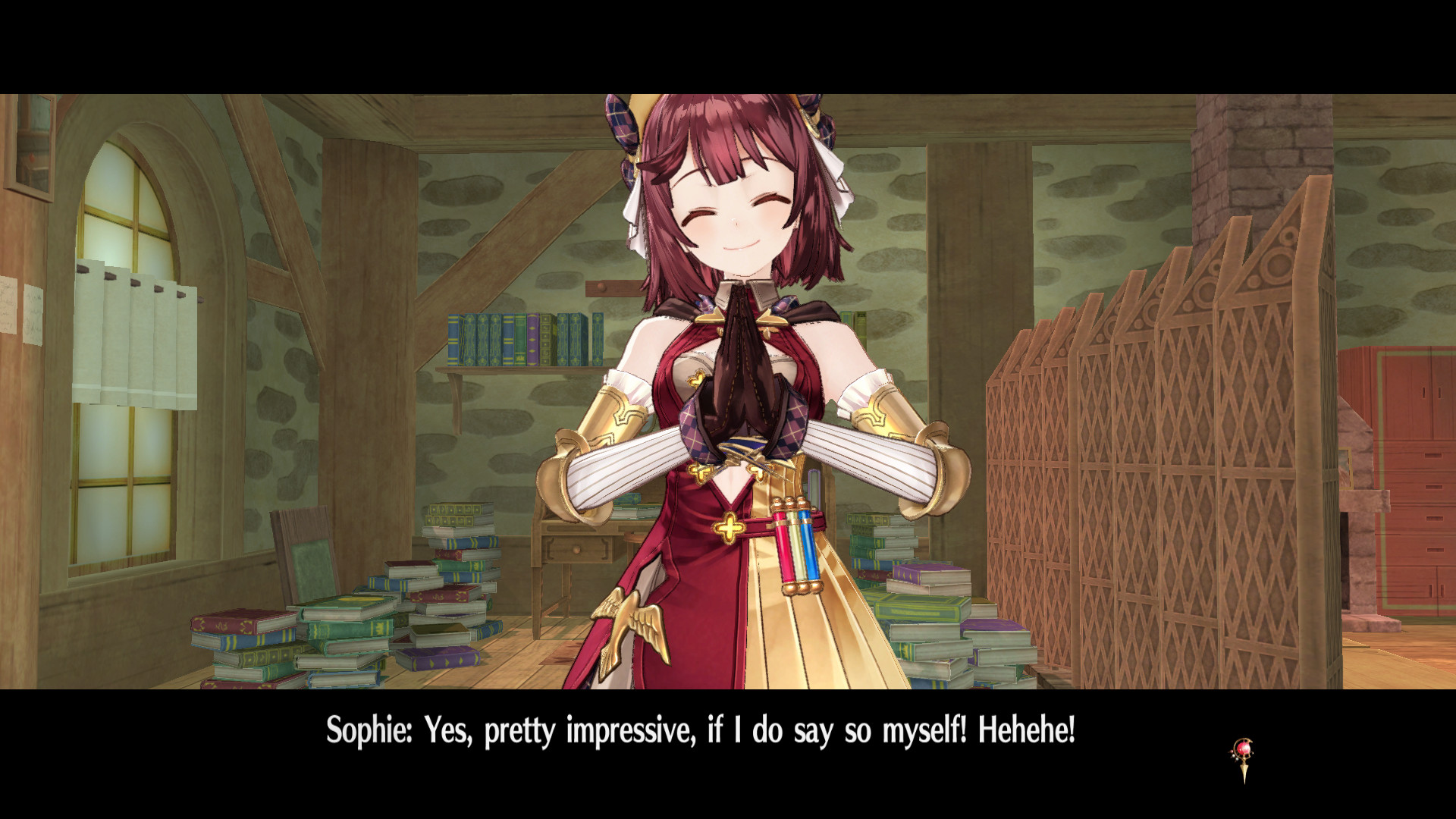
Verdict
So, in the end, should you pick up Atelier Sophie: The Alchemist of the Mysterious Book DX? If you have played any of the following or preceding Atelier games, you will likely find most of what you came to know and love from those games present here. The game is mostly focused on Sophie’s Alchemy skills with the rest of the game being more a distraction to help keep you entertained. Everything resolves around the Alchemy. The game will only advance once her skills get high enough, nothing else really matters. It does feel a bit overly grindy at times but there are enough distractions occurring that keep it interesting. If you are looking for a JRPG style game that has unique and interesting elements, you cannot go wrong with Atelier Sophie. Now if you will excuse me, my soup is nearly ready!

